As a Chan Buddhist and a follower of the Tao Te Ching, the notion of going to Beijing on an unrelated business trip was quite compelling. I had never been to China, despite a romanticised desire to one day travel it's historical and legendary pathways. With only a few days to spare I took a two hour train trip to Sydney (Australia) to secure my Visa from the Chinese Consulate. This is a very busy place amassed with various Chinese folk, and as an Irish descendant Australian, I prominently stood out in the Asian crowd.
"The tenderest things of creation prevail over the hardest. Something immaterial enters into the most impenetrable to preserve its unity."
-- Lao Tsu
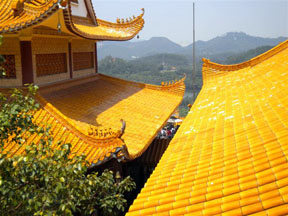
As a Chan Buddhist and a follower of the Tao Te Ching, the notion of going to Beijing on an unrelated business trip was quite compelling. I had never been to China, despite a romanticised desire to one day travel it's historical and legendary pathways.
With only a few days to spare I took a two hour train trip to Sydney (Australia) to secure my Visa from the Chinese Consulate. This is a very busy place amassed with various Chinese folk, and as an Irish descendant Australian, I prominently stood out in the Asian crowd. It surely was a wonderful opportunity to be a spectator.
Upon completion of all the preliminary forms, long lines of people stood at the counters with what seemed to be varying patience. Their task was to eagerly complete their administration and quickly exit. This proved to be quite a challenge for some as resistance to lining up erupted quickly. I later learned by observation that many Chinese resist the notion of lining up for anything. This was all too much for the security personnel who insisted to the point of physical handling that all people remained in their designated positions. My mind began to conjure up images of practices that go on in some meditation halls, where Lin chi/Rinzai followers will actually strike the disciples for drifting off. At this point I began to smile at the comic relief hoping not to get caught.
On departure from the counters a lady in her sixties happened to fall to the ground in a panic to comply. At this juncture I knew the whole situation was too heavily policed and I assisted her to a chair. She looked into my eyes with such gratitude and I knew in that moment that this apparent compliance with systems and structures was only skin deep, and that below the surface there existed a wonderfully humanistic pulse.
The Air China flight was pleasant with interesting samplings of air cuisine and movies with English subtitles. The plane landed in Shanghai and all passengers were asked to disembark and proceed through immigration (huh??). After completing immigration in Shanghai, we were asked to rejoin the plane and travel to Beijing. Mindfulness seemed the best option despite the loud and opinionated conversations arising within the passenger population. I concluded that this possibly could have been an introduction for the Beijing Olympics. I pondered what would happen to the Australian tourist trade if travellers were all taken to say Melbourne before being allowed to travel to any other destination. It then quickly came to mind ....."hey this is China, home of the providently mysterious and the unanswerable".
Beijing
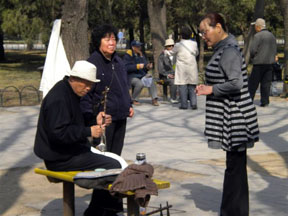 With business unexpectedly completed on the first day and seven days remaining before my return to Australia, I began organising activities and travel. With my trustee laptop and mobile phone (with global roaming) I could truly organise a trip to the moon....or that's what I thought! But China wasn't going to let me off so easy.
With business unexpectedly completed on the first day and seven days remaining before my return to Australia, I began organising activities and travel. With my trustee laptop and mobile phone (with global roaming) I could truly organise a trip to the moon....or that's what I thought! But China wasn't going to let me off so easy.
Leaving the hotel to go to Beijing West Railway Station, I struck my first real language barrier. The taxi driver and I couldn't understand a word each was saying and it was my first opportunity for patience and tolerance. There would be many more opportunities to follow. At first I thought it may have been my Australian accent, so I changed my accent to a poor mixture of Northern and Southern American. Perhaps I had watched too many movies but this was of little to no assistance in our quasi translations. I finally drew a picture of a train and he got the message.
When our taxi left the kerb we pulled straight out onto a seven lane highway with the existing traffic slamming on brakes, hitting horns and changing lanes with no blinkers. It was complete and utter mayhem. I began to practice breathing and in a short moment my smile returned in the presence of this awesome spectacle. The traffic included busses, trucks, motor bikes, scooters (carrying several members of the family), copious pushbikes and of course cars and endless taxis. We spent the fifteen minute trip into the city driving as fast as possible along the freeway whilst dodging both stationery and moving targets. The taxi driver seemed to enjoy the whole trip as he mocked my southern American accent attempts. His laughter was elevated to the point of hysteria when he learnt that I was actually Australian.
The taxi driver couldn't commit to dropping me at the front door of the railway station, so I alighted across the other side of an eight lane highway and had to walk across the elevated pathway provided. I focused heavily on breathing and acceptance as I flowed along the pathway with swarming hordes of Chinese, until we arrived inside the terminal. It was a wonderfully unique experience in that Beijing West Railway is perhaps the largest and busiest of railway terminals in the world. As I roamed inside, countless people were swarming here and there, speaking loudly and clearing their throats. The decibels were quite elevated as my ears and eyes adjusted to the massive activity beyond all understanding. The terminal is huge! While the Chinese of today are dressed in usually western style clothing, it conjured up images of masses of Chinese in traditional dress, during various eras, dynasties and communism.
My next task was to book a ticket to Shaoguan and check my luggage into a locker so that I was free to travel around Beijing. I approached the information counter, where about twenty people were assembled, all jockeying for supremacy to speak to the assistant. As there seemed to be an absence of structure (in that I could have been waiting indefinitely to be served), I made my way to what looked like the ticket office for the Shaoguan line.
A man in an official railway uniform who spoke broken yet helpful English, escorted me to a tiny booking office that I'd never have found without his help. We then had a long involved and quite strenuous conversation about the type of tickets available. After much deliberation I elected to toss a coin and settled for the top of a triple bunk of the (hard seat type) sleeper. This prompted both the ticket officer and the railway assistant to erupt in raucous laugher.
They were so patient and helpful with me, that the exchange of smiles became quite intoxicating as we comically entertained each other. I seem to have encountered this audience with them in a most provident way, in that there were no other willing passengers waiting to be served. In what seemed the busiest railway in the world and during peak hour, I had encountered a wonderfully timeless moment with two other sentient beings.
With peace within now restored, I approached another helpful employee who organised to place my luggage into a locker and tried to explain to me in lengthy detail that if I arrived back after a certain time, I would have to pay an extra fee. In recognition and acknowledgement I showed her my thumb and said "good" but this isn't a signal recognised in Chinese culture. I then tried the old pointer and thumb joined in a circle to which she tried to respond in kind with unusual laughter. One of the best things I knew to do, was to then get out my basic language translation cards and to my surprise the ease of the situation finally returned.
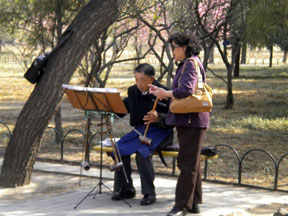 With my translation cards in tow I jumped into a taxi outside the railway and headed straight for Tiananmen Square, The Forbidden City and The Commemorative Gardens which are all absolutely massive and such rewarding tourist attractions. I remembered that these structures were well used in the classic film "The Last Emperor", a movie I so richly enjoyed.
With my translation cards in tow I jumped into a taxi outside the railway and headed straight for Tiananmen Square, The Forbidden City and The Commemorative Gardens which are all absolutely massive and such rewarding tourist attractions. I remembered that these structures were well used in the classic film "The Last Emperor", a movie I so richly enjoyed.
I also went to a huge place called the "Temple of Heaven" witch is a beautiful and vast expanse of gardens and cultural buildings, historically set up for reflection and universal prayer. During the day, this is where people do Tai Chi, organised dancing, and singing, as well as operatic singing with authentic stringed instruments. You will also find traditional Chinese games and sports in play. I thoroughly enjoyed the temples and stood in awe of so many Chinese people involved in such diverse recreation.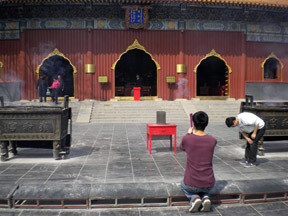 Next stop was the Lama Temple. With a long history, it was originally built in 1694 and was used as official residence for court eunuchs of the Ming dynasty. In 1723, the prince used half of the residence as an imperial palace and the other half was converted to a lamasery or a monastery for Mongolian and Buddhist Monks. It is now a typical Tibetan Monastery, with a strong following for Tsongkapa, the Tibetan saint. Having been closed for many years during the Cultural Revolution it was refurbished and reopened in 1980. Zhou Enlai is said to have saved it from destruction during that time and its now a working monastery with Mongolian Monks. It has five large halls and courtyards with decorative archways, typical Asian style upturned eaves and detailed carving.
Next stop was the Lama Temple. With a long history, it was originally built in 1694 and was used as official residence for court eunuchs of the Ming dynasty. In 1723, the prince used half of the residence as an imperial palace and the other half was converted to a lamasery or a monastery for Mongolian and Buddhist Monks. It is now a typical Tibetan Monastery, with a strong following for Tsongkapa, the Tibetan saint. Having been closed for many years during the Cultural Revolution it was refurbished and reopened in 1980. Zhou Enlai is said to have saved it from destruction during that time and its now a working monastery with Mongolian Monks. It has five large halls and courtyards with decorative archways, typical Asian style upturned eaves and detailed carving. 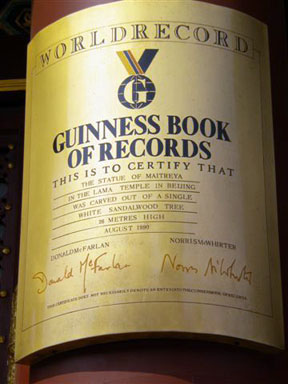 There is a treasury of Buddhist art, including sculptured images of gods, demons and Buddhas, as well as Tibetan-style murals. For some the main attraction is The Guinness Book of Records plaque noting the free standing Timber Buddha which is totally carved out of one piece of wood. While I 'm an avid Chan follower, I saw this complex as a great survivor of so many disruptions and I enjoyed the notion of its continuation, as well as its history for the love of Buddhism.
There is a treasury of Buddhist art, including sculptured images of gods, demons and Buddhas, as well as Tibetan-style murals. For some the main attraction is The Guinness Book of Records plaque noting the free standing Timber Buddha which is totally carved out of one piece of wood. While I 'm an avid Chan follower, I saw this complex as a great survivor of so many disruptions and I enjoyed the notion of its continuation, as well as its history for the love of Buddhism.
The area outside of the temple is a market with all manner of Buddhist artifacts and other interesting items. Browsing through the market was quite enjoyable and I was able to pick up some attractive malas and local incense.
It was now well into the afternoon and I decided upon a nice restaurant outside the temple grounds. After passing over items on the menu such as duck blood curd, fried bullfrog, chicken gizzard and cucumber icicles, I decided on long soup with vegetables followed by Chinese tea.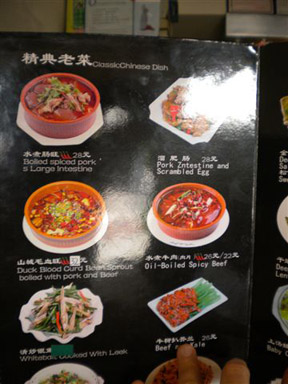 I also tried the vegetarian dumplings which I have to admit became quite a favourite. I've been watching my attachment to them ever since. The whole meal was well prepared and delicious, and I was relieved that the items on the menu were written in both English and Chinese. As I sat there eating mindfully amongst what seemed like Buddha town, excitement began to arise at the prospect of visiting both Nan hua si and Hong fa si monasteries in Southern China. Returning to breathing and presence I realised it was time to move.
I also tried the vegetarian dumplings which I have to admit became quite a favourite. I've been watching my attachment to them ever since. The whole meal was well prepared and delicious, and I was relieved that the items on the menu were written in both English and Chinese. As I sat there eating mindfully amongst what seemed like Buddha town, excitement began to arise at the prospect of visiting both Nan hua si and Hong fa si monasteries in Southern China. Returning to breathing and presence I realised it was time to move.
With little time left I jumped a taxi back to Beijing West Railway, reclaimed my luggage and headed for the departure terminal. Just waiting to board the train was awesome! There were thousands of other people waiting for several trains, laying all over the floor, drinking Chinese tea and eating noodles. I truly must have stood out as I felt I was in a goldfish bowl with hundreds of onlookers.
Upon entry to the train an assistant (again in official uniform) escorted me to my cabin, I was to share the cabin with five other Chinese, all of us on triple bunks. As I was on the top bunk with no ladder provided trying to get my luggage up to the top was amusing to say the least. Yes! I was roughing it, but the fun and jubilation was well worth it.
In the cabin it was night time and the carriage was a hive of activity of people making tea and heating up their noodles. Eventually we all bedded down for the night to which my experience became quite organic in that they all smelt and snored, but it was ok, I think I snored too.
In the morning the scenery outside was surprisingly unique and noticeably green, which was such a contrast to the dryness of Beijing. It was an authentic and scenic trip. I and another guy from Nigeria were the only English speaking people on the train, and in that moment I felt slightly isolated as it was quite a job to communicate with the Chinese, when my skills were so unworkable. The thought of studying a little Mandarin for the next trip became a certainty.
Shaoguan
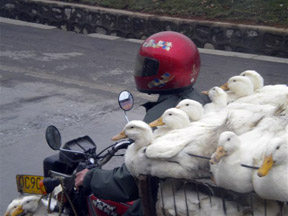 After finding a good hotel just near the Shaoguan railway station, I learned that its quite simple to catch a minibus to Nan hua si Monastery. The 20 Kilometre trip allowed for a little Southern China sight seeing. On the road I encountered an extraordinary image of a motor bike carrying copious quantities of ducks. Certain that these ducks would meet their demise I stayed in the moment to witness this strange yet unusual event.
After finding a good hotel just near the Shaoguan railway station, I learned that its quite simple to catch a minibus to Nan hua si Monastery. The 20 Kilometre trip allowed for a little Southern China sight seeing. On the road I encountered an extraordinary image of a motor bike carrying copious quantities of ducks. Certain that these ducks would meet their demise I stayed in the moment to witness this strange yet unusual event.
Upon arrival at Nan hua si Monastery a wave of joy arose within and I stood in contemplation of the history I was about to witness. Founded in 502 by the Indian monk Zhiyao Sanzang, the temple became famous through the activities of Huineng. His successors spread his doctrine of Nanzong Chanfo, or Chan Buddhism, throughout China from where it filtered into Japan as Zen, and Korea as Son.
With a background in horticulture and natural sciences I quickly noticed the surrounding maple trees and Chinese cypresses. According to the handout from the front desk the temple grounds are 12,000-square-metres.
 Upon entry to the monastery through the Caoxi Gate, there is a Life-saving pond (Fangsheng chi) and the Five Fragrances Pavilion. At this juncture an eerie feeling arose about a portion of the history of the monastery, in that it was bombed by the Japanese during the Hsu Yun era. I looked to the hills with some imagining of the two Japanese planes which collided in mid air resulting in a retreat from further attack.
Upon entry to the monastery through the Caoxi Gate, there is a Life-saving pond (Fangsheng chi) and the Five Fragrances Pavilion. At this juncture an eerie feeling arose about a portion of the history of the monastery, in that it was bombed by the Japanese during the Hsu Yun era. I looked to the hills with some imagining of the two Japanese planes which collided in mid air resulting in a retreat from further attack.
Flowing forward past manicured bonsai gardens I arrived at seven halls full of relics, and behind a second gate to reach the Lokapala Hall. The shrine is in the centre and flanked by the four heavenly kings. Following is the Mahayana Hall containing an eight metre tall statue of Avalokitesvara. On the side of the hall are the Bell and Drum Towers. On top of the bell tower there hangs a brass bell from the Southern Song Dynasty. The massive bell is 2.75 meters high with a diameter of 1.8 meters.
The Grand Hall, constructed during the Yuan Dynasty, stands in the center of the monastery. Covered by glazed tiles, it houses the statues of Shakyamuni, The Medicine Buddha, and Amitabha, which are here with 500 fine clay sculptures of Buddhist arhats.
Relics including scrolls of scriptures and iron images are located in the Tripitaka Pavilion. At the back of the Monastery is a spring called Jiulong Quan. This is said to be an area where the patriarch washed his robes and sat in the sun. I took some time to sit at the spring to practice mindfulness and eventually (as a gesture to the peaceful location and honouring of the path) I dowsed myself with the historical and refreshing spring water.
After Huineng passed away, his body was considered as an immortal body, and was mummified. A lacquered model, said to be the actual mummy, is located in the Sixth Master Hall. His kasaya robe (embroidered with 1,000 Buddhist images), his alms bowl, shoes and a stone pendant are in the same location.
There is also a strong Hsu Yun presence due to his tireless work to restore the monastery and bring about sanity to the disputing monks of the era. I spent some time next to his building quarters and reflected what it might have been like to sit with him in meditation and be present during his enlightened discourses.
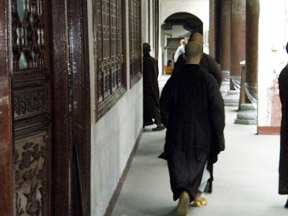 The monastery has numerous other buildings where monks and nuns live and dwell. Between them are paths and walkways which are ideal for practicing mindful breathing, walking, stillness and noble silence. On my journeys I wandered into the main courtyard of the nun's quarters to which they were practicing silent head shaving in the sunny and manicured gardens.
The monastery has numerous other buildings where monks and nuns live and dwell. Between them are paths and walkways which are ideal for practicing mindful breathing, walking, stillness and noble silence. On my journeys I wandered into the main courtyard of the nun's quarters to which they were practicing silent head shaving in the sunny and manicured gardens.
At lunchtime one monk sounded the traditional tapping followed by bell ringing to alert the monks to their meal. Standing to watch the procession the monks smiled and offered joyful greetings as they passed by. As it was meal time I headed for the vegetarian restaurant and gift shop over on the east side of the monastery grounds. 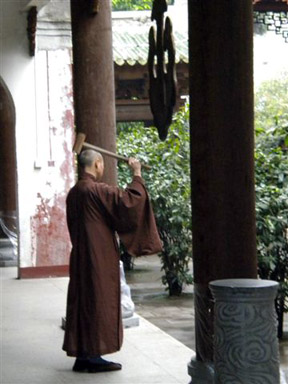 Here I pointed to undecipherable items on the menu with only Chinese writing and hoped for the best. Fortunately the meal of sizzling bean curd was tasty and satisfying. The gift shop sells tiancha, a special liquorice-flavoured tea made by Nanhua's nuns.
Here I pointed to undecipherable items on the menu with only Chinese writing and hoped for the best. Fortunately the meal of sizzling bean curd was tasty and satisfying. The gift shop sells tiancha, a special liquorice-flavoured tea made by Nanhua's nuns.
After further meditation and ponderings I made my way out of this beautiful monastery and caught a hire car (with a friendly driver) back the hotel at Shaoguan. On checking emails a friend who was helpfully assisting to watch my timing offered the idea that I could possibly travel to Mt Wudang after ShenZhen. Childhood images of Chinese monasteries checked into mountains, Tai Chi, Kung fu and The Tao all entered my mind as I explored this hopeful possibility.
Well as china would have it, I hit a wall of schedules, times and communication misunderstandings. For some unknown and yet to be discovered reason I couldn't board my home plane from Shanghai airport, despite the fact that the plane actually stopped there on its way from Beijing. Go figure??! To this end I had to then make my way back to Beijing from Southern China leaving time a little short.
With this in mind I decided to still go onto ShenZhen as planned and attempted to book my ticket accordingly. I responded to my email friend with "I'll go onto beautiful Hong fa si monastery after all. Glorious Mt Wudang will have to be patient till next time".
In buying my ticket I consulted a group of local travel agents in Shaoguan who helped me immensely. After the mishap of not being able to go to Mt Wudang despite all of their research using a Chinese/English dictionary, they then curtailed their thinking and helped me book for ShenZhen. They were particularly enthusiastic upon learning that I was a Buddhist. The owner wore a mala and bowed to me in acknowledgement. When I asked them if there was an ATM close by one of them took me into town and paid for the cab, then waited for me to withdraw some cash and walked me back to the station. On the way back to the hotel after purchasing my ticket (using his carefully written note), I called into a local restaurant to buy a drink and there they all were eating dinner. They refused to let me go and filled up bowls of local dishes for me to eat. I tried to pick up the cheque for the dinner but they refused to let me pay. They then wished me well and kept waving as I bowed at them in gratitude. Such random acts of kindness. It was like manna from heaven.
Shenzhen
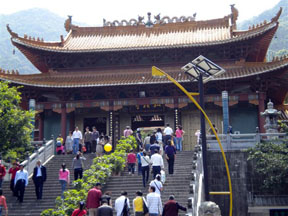 The day train from Shaoguan to ShenZhen takes about four hours and I settled into a hotel in the city and prepared for dinner. In front the restaurants below the hotel, live tanks exhibited eels, catfish and other sentient sea creatures. Perplexed I headed for the city centre to seek out an appropriate restaurant and stumbled upon a strange cafe. I ordered a green tea cappuccino and giggled at the notion that tea seemed to be in everything. After sampling this unusual yet disgusting beverage in a strange receptacle, I eventually struck a good menu downtown.
The day train from Shaoguan to ShenZhen takes about four hours and I settled into a hotel in the city and prepared for dinner. In front the restaurants below the hotel, live tanks exhibited eels, catfish and other sentient sea creatures. Perplexed I headed for the city centre to seek out an appropriate restaurant and stumbled upon a strange cafe. I ordered a green tea cappuccino and giggled at the notion that tea seemed to be in everything. After sampling this unusual yet disgusting beverage in a strange receptacle, I eventually struck a good menu downtown.
Shenzhen is a lively and colourful city almost like a mini Los Vegas. An English spoken fellow on the train explained that its principle trade with nearby Hong Kong was primarily of silk. These days it remains one of China's special economic zones.
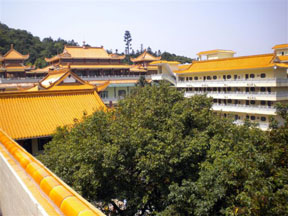 The next morning I caught a taxi directly to Hong fa si Monastery. Hong fa si was quite a different experience to Nan Hua in that its a highly popular destination. As the monastery itself seems incorporated into the botanical gardens, so many visit both sites. It was quite interesting to see the temple and statue worshipping by the Asian visitors from all over. It reminded me of the Theravada practices that go on by the Malaysians and Sri Lankans.
The next morning I caught a taxi directly to Hong fa si Monastery. Hong fa si was quite a different experience to Nan Hua in that its a highly popular destination. As the monastery itself seems incorporated into the botanical gardens, so many visit both sites. It was quite interesting to see the temple and statue worshipping by the Asian visitors from all over. It reminded me of the Theravada practices that go on by the Malaysians and Sri Lankans.
The monastery is well serviced and is the newest in China. It was also the first one built after 1949. The name of the temple, pronounced as"hong fa," are abbreviations for "hongyang fofa," which translates as "spreading Buddhist principles."
Hong fa si consists of five levels of main halls, dedicated to the Buddha, other deities and Buddhist scriptures. A bell tower in the east and drum tower in the west add to the grandeur of the structures. An aerial view of the monastery buildings actually resembles the shape of a pagoda.
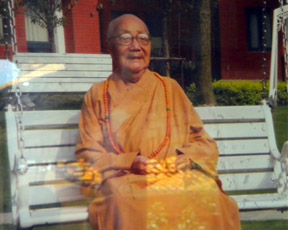 Inside the monastery grounds I was able to meet and greet Master Ben Huan, one of the two oldest living Chan Masters of Chinese descent still living, and the highly revered abbot of Hong Fa Si. It seemed easier to convey with Master Ben Huan's assistant after kowtowing to Master Ben Huan and receiving blessings. Master Ben Huan transmitted his acknowledgement through this way. I also participated in the specific tradition of donating money. A small red envelope is used, with a small amount of money enclosed, the enveloped is then presented to a priest or the Abbot with two hands. Then follows kowtowing either once, but not more than three times.
Inside the monastery grounds I was able to meet and greet Master Ben Huan, one of the two oldest living Chan Masters of Chinese descent still living, and the highly revered abbot of Hong Fa Si. It seemed easier to convey with Master Ben Huan's assistant after kowtowing to Master Ben Huan and receiving blessings. Master Ben Huan transmitted his acknowledgement through this way. I also participated in the specific tradition of donating money. A small red envelope is used, with a small amount of money enclosed, the enveloped is then presented to a priest or the Abbot with two hands. Then follows kowtowing either once, but not more than three times.
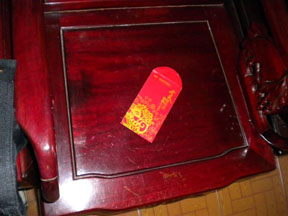
Later, Master Ben Huan's assistant actually chose me out of the crowd to converse and have a photo taken. He also acknowledged the many other Buddhists who line up to visit Master Ben Huan daily. I'm also told that for the reasons noted above, Hong Fa Si might be considered the most important monastery in China today as it is visited by so many people due to its proximity to Hong Kong. The Monastery has donated more than 50 million Yuan (US$7.35 million) to charity and for public facilities.
Master Ben Huan recently handed over his title of abbot to a young monk known as Yinshun who is a 38 year old graduate from Beijing. The ceremony attracted over 5000 people. Locally the monastery also holds some strong relevance in that Chuan Zhi (our own abbot of ZBOHY) was ordained at Hong Fa Si in 1998.
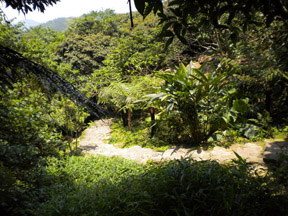 Leaving the monastery there are many wonderful paths through the botanical gardens to practice walking mindfully. The walking path to the main gate is several kilometers and well worth the sight seeing. Apart from pleasant scenery you can also encounter statues of the various Chinese astrological animals with the ox being well represented this year. On the path I encountered one Chinese fellow undertaking the Tibetan Buddhist practice of taking just a few steps and prostrating on the ground. He actually drew a crowd as they witnessed this old tradition.
Leaving the monastery there are many wonderful paths through the botanical gardens to practice walking mindfully. The walking path to the main gate is several kilometers and well worth the sight seeing. Apart from pleasant scenery you can also encounter statues of the various Chinese astrological animals with the ox being well represented this year. On the path I encountered one Chinese fellow undertaking the Tibetan Buddhist practice of taking just a few steps and prostrating on the ground. He actually drew a crowd as they witnessed this old tradition.
Back in the main streets I visited several Buddhist related shops before heading for the old part of ShenZhen city where I think I found every type of old world market available. It was such a blessing to stroll through the hive of activity in what may be described as raw cultural mayhem. It was a diverse market and a terrific arena for retail therapy, boasting huge clothing sheds, trinket and jewelry stands, street kitchens with tasty snacks and restaurants offering traditional Chinese menus. It was such a treat that I stayed till well after dark.
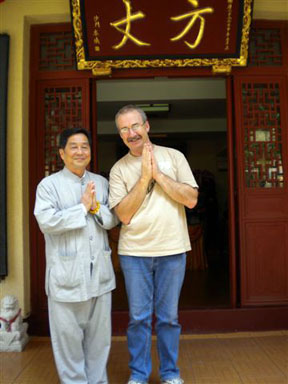 With my short but profound trip through Southern China now complete, it was time to purchase a plane ticket and head back to Beijing for my journey home.
With my short but profound trip through Southern China now complete, it was time to purchase a plane ticket and head back to Beijing for my journey home.
In closing, I found my travels in China to be a real opportunity for Chan practice, in that I encountered so many opportunities to witness duality, to introduce mindfulness and to continually introduce a Hua Tou. Genuinely the people, the scenery, the architecture were so interesting and the beautifully attractive monasteries ranged from extraordinarily popular to quietly still, peaceful and Zen-like.
By the provident nature that seemed to provoke my travel to China, one can only request a swift return. There is just so much more to see and experience.
Amitofo
Yin Shan
